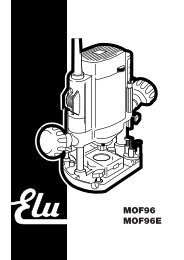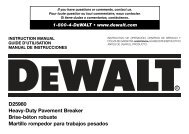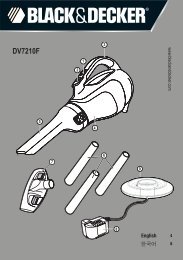kombinasjonssag dw743 - Service - DeWalt
kombinasjonssag dw743 - Service - DeWalt
kombinasjonssag dw743 - Service - DeWalt
You also want an ePaper? Increase the reach of your titles
YUMPU automatically turns print PDFs into web optimized ePapers that Google loves.
ENGLISH<br />
● Pull down the head until the blade just enters the saw kerf.<br />
● Place a square (66) against the left side (7) of the fence and blade (62)<br />
(fi g. G2). The angle should be 90°.<br />
Do not touch the tips of the blade teeth with the square.<br />
● If adjustment is required, proceed as follows:<br />
● Rotate the eccentric adjustment bush (67) until the face of the saw<br />
blade is fl at against the square (fi g. G1).<br />
● Tighten the locking screw (65).<br />
● Check that the red marks (68) near the blade slot (52) are in line with<br />
the 0° position (69) on the two scales (fi g. H).<br />
● If adjustment is required, loosen the screws (70) and bring the<br />
indicators in line. The 45° position should now also be accurate.<br />
If this is not the case, the blade is not perpendicular to the rotating<br />
table (see below).<br />
Checking and adjusting the blade to the table (fig. I1 & I2)<br />
● Loosen the bevel clamp knob (22) (fi g. I1).<br />
● Press the saw head to the right to ensure it is fully vertical and<br />
tighten the bevel clamp handle.<br />
● Pull down the head until the blade just enters the saw kerf.<br />
● Place a set square (66) on the table and up against the blade (62)<br />
(fi g. I2). The angle should be 90°.<br />
Do not touch the tips of the blade teeth with the square.<br />
● If adjustment is required, proceed as follows:<br />
● Loosen the bevel clamp knob (22) (fi g. I1) and turn the vertical<br />
position adjustment stop screw (71) in or out until the blade is at 90°<br />
to the table as measured with the square (fi g. I2).<br />
Checking and adjusting the mitre angle (fig. A1, A2 & H)<br />
The straight cross-cut and 45° mitre positions are pre-set.<br />
● Pull up the rotating table location plunger (8) and rotate it<br />
counterclockwise a quarter of a turn (fi g. A1).<br />
● Loosen the rotating table clamp handle (5). The handle allows a<br />
ratchet-type action when full rotation of the handle is not possible.<br />
● Grip the control handle (14) (fi g. A2), compress the guard retraction<br />
lever (13) and lower the saw about halfway (fi g. A1).<br />
● Turn the sawhead with its rotating table to the required position.<br />
● Tighten the rotating table clamp handle (5). The rotating table<br />
location plunger (8) will engage automatically (fi g. A1).<br />
Using the red marks (68), the rotating table (4) can be set to any mitre<br />
angle left or right between 0° and 45° (fi g. H).<br />
● Proceed as for pre-set positions. The rotating table location plunger<br />
cannot be used for intermediate angles.<br />
Always make a trial cut in a piece of waste wood, to check<br />
for accuracy.<br />
Adjusting the fence (fig. J1 & J2)<br />
The moveable part of the left side of the fence can be adjusted to<br />
provide maximum support of the workpiece near the blade, while<br />
allowing the saw to bevel to a full 45° left. The sliding distance is limited<br />
by stops in both directions. To adjust the fence (7):<br />
● Lift the lever (72) to release the fence (7).<br />
● Slide the fence to the left.<br />
● Make a dry run with the saw switched off and check for clearance.<br />
Adjust the fence to be as close to the blade as practical to provide<br />
maximum workpiece support, without interfering with the up and<br />
down movement of the arm.<br />
● Push the lever (72) down to secure the fence in place.<br />
Checking and adjusting the bevel angle (fig. J1, K1 & K2)<br />
● Slide the side fence to the left as far as it will go (fi g. J1).<br />
● Loosen the bevel clamp handle (22) and move the saw head to the<br />
left. This is the 45° bevel position.<br />
● If adjustment is required, proceed as follows:<br />
● Turn the stopscrew (73) in or out as necessary until the pointer (74)<br />
indicates 45°.<br />
Assembly for saw bench mode<br />
Changing from mitre saw to saw bench mode<br />
(fig. A1 - A3, E2, L1 & L2)<br />
● Put the blade into 0° cross-cut position with the rotating table location<br />
plunger (8) correctly located and the rotating table clamp (5) secured<br />
(fi g. A1).<br />
● Slacken the riving knife clamp bolt (75) just enough to allow the riving<br />
knife to enter the mounting slot (fi g. L1).<br />
● Take the riving knife (16) from its storage position against the saw<br />
head (fi g. A2).<br />
● Depress the guard release lever (13) to release the blade guard (12),<br />
then raise the blade guard as far as possible (fi g. A1).<br />
● Slide the riving knife bracket (76) fully into the mounting slot (77)<br />
(fi g. L1). Tighten the clamp bolt.<br />
● Gently release the lower guard until it is held in place behind the<br />
edge protruding from the inside of the riving knife.<br />
● Remove the under-table guard.<br />
● Pull down the saw head and swing the height adjuster (23) until its<br />
U-shaped bracket (56) engages on the pin provided in the base<br />
(fi g. E2).<br />
● Turn the wheel (55) of the adjuster to make the blade and riving knife<br />
protrude from the saw bench table (24) (fi g. A3) to provide maximum<br />
cutting depth in saw bench mode.<br />
The blade should not foul the lower blade guard.<br />
● Pull the table release lever (2) to the left, lift the front edge of the<br />
table and fl ip it back through 180° until the teeth of the table-locking<br />
device (20) automatically engage the saw blade retention lever to<br />
secure it in the saw bench mode (fi g. L2).<br />
Be careful not to lose control over the movement of the table.<br />
Position of the riving knife (fig. M)<br />
● Fit the riving knife (16) as described above. Once fi tted, the riving<br />
knife does not require further adjustment.<br />
Fitting the upper blade guard (fig. N)<br />
The upper blade guard (25) is designed to be quickly and easily<br />
attached, via a spring-loaded plunger to the hole in the riving knife (16)<br />
once it has been positioned through the worktable for saw bench mode.<br />
● Secure the upper blade guard (25) to the riving knife by pulling the<br />
knob (76) to allow the plunger in the guard to engage.<br />
Never use your saw in saw bench mode without the upper<br />
guard correctly fi tted.<br />
Mounting and adjusting the parallel fence (fig. O)<br />
The dual height parallel fence (26) can be used in two positions (11 or<br />
60 mm). The parallel fence can be mounted on either side of the blade.<br />
To mount the fence into the appropriate position, proceed as follows:<br />
● Loosen the knob (77).<br />
● Slide the bracket on from the left or the right. The clamping plate (78)<br />
engages behind the front edge of the table.<br />
● Tighten the knob (77).<br />
35

















